:max_bytes(150000):strip_icc()/VWH-Paige-McLaughlin-Natura-Pain-Relief-Herbs-Standard-20f690ae9d3a4fe994f76e24cf66343c.jpg)
Embarking on Holistic Pain Relief: A Comprehensive Wellness Approach
Living with persistent pain can significantly impact one’s quality of life, and seeking relief often requires a multifaceted approach. Holistic pain relief goes beyond merely addressing symptoms; it embraces a comprehensive wellness strategy to alleviate pain and improve overall well-being. Explore the transformative journey to holistic pain relief and discover a path towards a pain-free life.
Understanding Holistic Pain Relief
Holistic pain relief recognizes pain as a complex interplay of physical, mental, and emotional factors. Unlike conventional approaches that may focus solely on symptom management, holistic pain relief delves into the root causes of pain, addressing them from multiple angles. This comprehensive strategy aims not only to alleviate pain but also to enhance overall health and vitality.
Now, let’s delve into the world of Holistic Pain Relief. Click here to explore how this approach can transform your journey to a pain-free life.
Mind-Body Connection in Pain Management
The connection between the mind and the body is a central theme in holistic pain relief. Practices such as mindfulness, meditation, and relaxation techniques play a crucial role in managing pain. By fostering a positive mental state, individuals can often experience a reduction in the perception of pain and an improved ability to cope with discomfort.
Nutrition and Anti-Inflammatory Foods
Dietary choices play a significant role in holistic pain relief. Anti-inflammatory foods, rich in omega-3 fatty acids, antioxidants, and other nutrients, can help reduce inflammation and alleviate pain. A nutritionally balanced diet supports overall health and contributes to the body’s natural ability to heal.
Physical Activity and Exercise for Pain Management
Engaging in regular physical activity and exercise is a key component of holistic pain relief. Tailored exercise routines, such as yoga, swimming, or gentle stretching, can improve flexibility, strengthen muscles, and promote better circulation. These activities contribute to pain reduction and enhance overall physical well-being.
Alternative Therapies and Complementary Medicine
Holistic pain relief often integrates alternative therapies and complementary medicine. Practices like acupuncture, chiropractic care, massage therapy, and herbal remedies may complement conventional treatments, offering additional avenues for pain management. The synergy of these approaches addresses pain on various levels.
Stress Reduction Techniques for Holistic Wellness
Chronic stress can exacerbate pain and contribute to its persistence. Holistic pain relief includes stress reduction techniques such as biofeedback, deep breathing exercises, and progressive muscle relaxation. By managing stress, individuals can positively impact their pain experience and promote overall well-being.
Quality Sleep as a Foundation for Pain Relief
Adequate and restful sleep is crucial for holistic pain relief. Sleep is a time when the body undergoes repair and regeneration, and disruptions to sleep patterns can intensify pain. Establishing healthy sleep hygiene practices contributes to the overall effectiveness of holistic pain management.
Counseling and Emotional Support
The emotional aspect of pain should not be overlooked in holistic pain relief. Counseling and emotional support provide individuals with tools to cope with the psychological impact of pain. Addressing emotional well-being fosters resilience and a more positive outlook on the journey to pain relief.
Holistic Pain Relief in Chronic Conditions
For individuals dealing with chronic pain conditions, holistic approaches offer sustainable strategies for long-term relief. Managing conditions such as arthritis, fibromyalgia, or migraines requires a comprehensive plan that considers the unique aspects of each individual’s health and lifestyle.
Educating and Empowering Individuals
Holistic pain relief is not only about providing solutions but also about educating and empowering individuals to actively participate in their well-being. Understanding the factors contributing to pain and the role of holistic strategies equips individuals with the knowledge to make informed choices for their health.
Integrating Holistic Pain Relief into Daily Life
The true effectiveness of holistic pain relief lies in its integration into daily life. It’s not a one-size-fits-all solution but a personalized and evolving journey. By consistently incorporating holistic practices, individuals can experience the transformative power of comprehensive wellness in their pain relief efforts.
Embrace a Pain-Free Life with Holistic Relief
In conclusion, holistic pain relief offers a transformative approach to managing and alleviating pain. By addressing physical, mental, and emotional aspects, individuals can embark on a journey to a pain-free life that prioritizes overall well-being. To explore more about holistic pain relief, visit Holistic Pain Relief and take the first step toward a life with less pain and more vitality.



